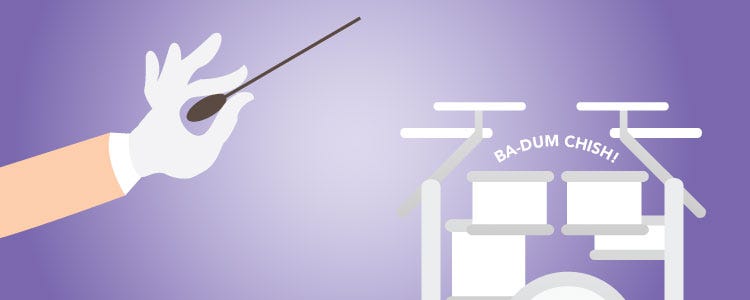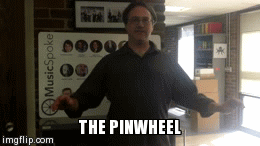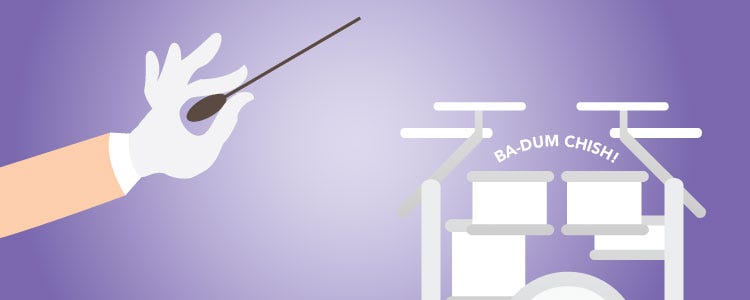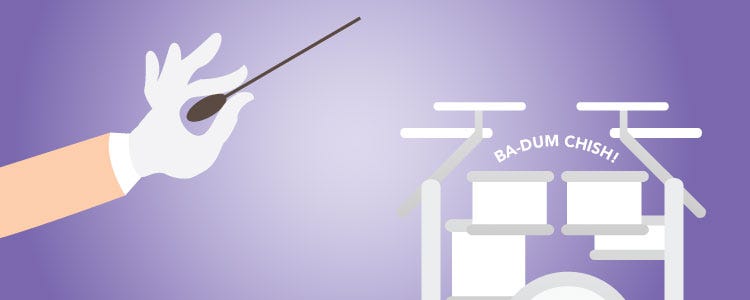Are You A GIFted Conductor? Compare Yourself To Kurt Knecht.
Are you a GIFted Conductor | MusicSpoke
As the new school year begins, I thought it was an appropriate time for the annual reposting. There are links to the other blogs in this series at the bottom.
The following gestures are absolutely real. I have seen them all used except one which the amazing Tim Tharaldson demonstrated for me. The final four should not be attempted except by the most advanced conductors.
1. The Pinwheel
A favorite gesture of some modern conductors, the pinwheel gesture effectively communicates a minimum amount of information with a maximum amount of motion. When it comes to enigmatic power, the “pinwheel” is almost without peer.
2. The Basketball
This perennial favorite of student conductors is achieved by always returning the ictus to the same location irrespective of the beat. When you want to communicate a long line by obscuring the location of beat one, this is the perfect conducting tool. As you improve, try switching the ball between hands while still keeping the ictus in a central location.
3. The Bruce Lee
Almost every conducting class I’ve played for included the recommendation to keep the hand fairly horizontal. There are a lot of good reasons for this, but not if you want to achieve true slicing power. For this, you will need to turn your hand vertically and imagine that you are physically punishing an opponent. Truly advanced conductors can also attempt to combine this with “drunken master” style conducting.
4. The Disembodied Hand
If you want to communicate a mechanical sense of pulse with no sense of emotional connection or music engagement, this is the gesture for you! It becomes even more effective when you use it in combination with a baton.
5. Surprise Attack
This gesture gained most of its popularity in pit orchestras for musicals and operas but soon spread throughout the country. Originally developed as a corrective to the redundant “business beats”, the conductor minimizes any preparatory gesture and focuses on a downward motion. Mastering this gesture requires you to be ambiguous about where the “bottom” of the gesture is and that you simultaneously look surprised and angry because the band didn’t play.
6. Big Wheel Keep on Turning
Quite rightly, the “forward turning wheel” gesture is better known by its academic name, “The modified von Karajan”. In this gesture, you should imagine wrapping a hose or piece of twine around a stick. The secret trick to perfect this gesture is to make sure that you are a little unclear yourself about whether the beat is occurring at the top or bottom of the circle. Once you have that down, you will know all that this powerful gesture can communicate.
7. Big Wheel/Pinwheel Combo Platter
We are now entering into the territory of advanced conducting techniques. These gestures are so powerfully communicative, that only the most advanced conductors should attempt to wield their legendary force. When one gesture doesn’t seem to work alone, try combining it with another. The Big Wheel/Pinwheel Combo combines the opacity of the Big Wheel gesture with the impenetrability of the Pinwheel. In the hands of a lesser conductor, this gesture can be almost meaningless.
8. The Catch and Release
The “catch and release” is a multipart gesture for closing a slow movement. When the last note of a piece is being quietly held by the performers, reach out and grasp it gently with the right hand. As you feel its magical pulsation begin to wane, gently allow your fingers to wrap around the sound individually beginning with the pinky. Once the delicate sound is contained in the hand, shake it a few times to make sure it is dead, and then set it free.
9. Stir the Soup
I first learned this gesture after the Berlin Wall fell. At the reunification concert when Berstein conducted the Beethoven 9, he used a gesture that surely must be the historical pre-cursor to the “Pinwheel” and the “Big Wheel” gestures. This gesture is most effective with a baton. Point the baton down at the ground and imagine it is a large ladle. Use the left hand to imagine you are clearing steam away from a large pot. Imagine the notes are bits of okra and andouille sausage floating to the surface.
10. Cutoff with Warrior Pose
I’ve only seen this gesture used effectively one time. I’m not sure it can ever be repeated. In moments of great desperation, it is very difficult to defend against this movement.
Want more of Kurt’s thoughts on conducting? Click the links below.
Are You A Gifted Conductor 2
GIFted Conductor | MusicSpoke I’m back again with the latest moves I’ve picked up from conductors. If you are tired of simply beating time, try some of the sweet conducting gestures I’ve learned recently. The Mouth-Breather
Are You A GIFted Conductor 2
Are you a GIFted conductor 3?
Are you a GIFted Conductor | MusicSpoke[/caption] It’s been a while since I’ve helped the conducting world out by keeping you all informed about the conducting trends and latest and hippest gestures. I’ve continued my intensive research since the last time I posted, and I’m happy to report five new suggestions that I’ve discovered to help you improve you…
Are you a GIFted conductor 3
















